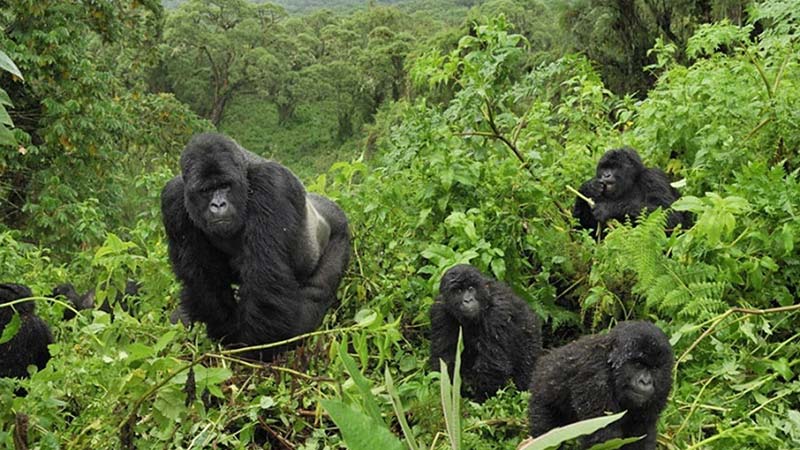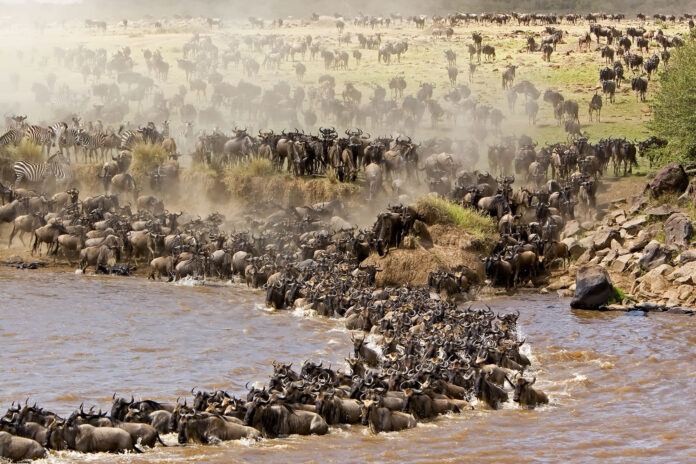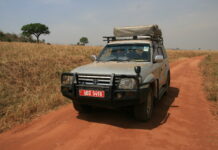Each year, over two million wildebeest, zebra and other herbivores trek from the southern Serengeti to the lush green grasses of the Masai Mara. Known as one of the seven wonders of the world, the great migration is an iconic safari must-see.
The Great Migration is the ever-moving circular migration of over a million animals across the Serengeti-Mara ecosystem. The constant movement of columns of wildebeest, joined by a host of companions, follow an age-old route in search of grazing and water.
After calving in the southern part of Tanzania’s Serengeti near the Ngorongoro Conservation Area, the animal’s journey through the Serengeti up and around in a clockwise direction towards the Masai Mara in Kenya, before returning once again near the end of the year. Along the way, high drama is always present, as thousands of animals are taken by predators and thousands more are born, replenishing the numbers and sustaining the circle of life.
During June, the dry season starts with large concentrations of wildebeest in the Western Serengeti and on the southern banks of the Grumeti River. Each migrating animal must face the challenge of crossing the crocodile-infested river — the first of many daunting and tense river encounters.
As June moves into July, the hundreds of thousands of wildebeest and zebra continue to head north along the western edge of the park toward an even riskier barrier: the Mara River in the north of the Serengeti. These river crossings are arguably one of the most exciting wildlife events on Earth. They usually begin at the onset of high season in July, but timing all depends on nature.
By August, the herds have faced the challenge of crossing the Mara River and are spread throughout the Maasai Mara’s northern region, with many remaining in the northern Serengeti. In years when the river is in full flow, the panic and confusion at the crossings combined with waiting predators and surging currents can cause massive loss of life.
But, even in years of relatively gently flowing water, the crocs take their toll, not to mention the lions and other large predators that patrol the banks, ready to ambush any wildebeest that make it to the other side. There is no single crossing: at some spots, there are just a few individuals, while others see a mass of animals moving without break for hours.
By September to October, the main chaos has ended and the migrating columns have gradually moved eastward. However, they wildebeest will face the heavy waters of the Mara River once more as they prepare to cross once again for their return journey southward.
The herds will typically be found in the Northern Serengeti in the month of July, where access is provided by Asilia’s mobile migration camps as well as Sayari Camp (for those looking to indulge just a little bit more).
Later in July, those animals that have successfully made it across the Mara River will also be found in the Masai Mara, where guests of Rekero Camp can watch river crossings right from the main deck of the camp on their Kenya safari. At this time, daily river crossings can be seen at the Mara and Talek rivers, both often central to incredible scenes.
After the East African short rains in late October and early November, the wildebeest move down from Kenya and into the eastern limits of the Serengeti past Namiri Plains, an area known for outstanding cheetah sightings. By December, they are spread throughout the eastern and southern reaches.
In the early months of the New Year, the grasses in the deep south of the Serengeti are lush with rain. This draws the herds of wildebeest and hundreds of thousands of zebras and other plains animals. The cycle continues as the calving season starts once again.
Plan your Tanzania safari depending on the movement of these great beasts. After all this, cross to Uganda for gorilla safari encounter. Remote Bwindi Impenetrable National Park is a renowned mountain gorilla sanctuary.
Led by experienced Uganda Wildlife Authority guides, you will be introduced to the ecology of the forest and the changing landscape as you trek to the gorillas. Your guides are in communication with the team of trackers who will have been shadowing the gorillas since daybreak. The trackers direct your guides to bring you to the gorillas.

The limit on group size of 8 is to keep to gorillas safe from any airborne pathogens, but also to increase the chances of sightings, as larger groups often scare off these timid animals. Once contact is made, there is usually a silent wait, deep within the dense foliage, as the gorilla’s edge closer.
When they do emerge, seeing the gorillas in their natural habitat, the verdant forest providing the perfect backdrop, is a truly breath-taking experience. Any silence is soon broken by the rustling of leaves as the gorillas wander and play, and the calls, whistles, and whoops of thousands of animal species for miles around provides the perfect sound-track.
Once contact is made, you have up to one hour to spend with the gorillas. If you wanted to spend longer, you can take part in a gorilla habituation experience, and spend up to 4 hours with these gentle giants.





